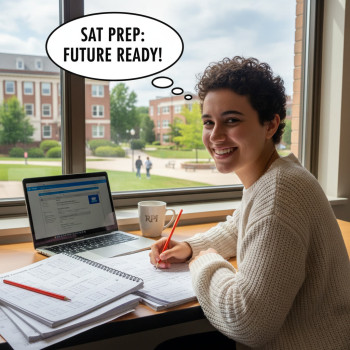Why adapting your study style matters more than just “studying harder”
You’ve probably heard the advice: “Study more.” That’s useful—up to a point. But if your study methods don’t match how you actually learn, you’ll hit a ceiling. The SAT isn’t just a test of what you know; it’s a test of how you perform under time pressure, how you reason through unfamiliar problems, and how well you recover from mistakes mid-test.
Adapting your study style means taking honest stock of your natural strengths (visual, auditory, kinesthetic, or read/write), then applying techniques that convert hours of effort into real score gains. In plain terms: smarter practice beats longer practice.
Know the test so you can match study style to task
Before we customize techniques, let’s refresh what you’re preparing for. The modern SAT is a 3-hour test (150 minutes of active testing) with two main score components: Evidence-Based Reading and Writing (EBRW) and Math, together scored from 400 to 1600. There is no optional essay anymore.
- Reading: 65 minutes, 52 questions. Passages include literature, history/social studies, and science. Questions focus on main ideas, evidence, inferences, and vocabulary-in-context.
- Writing & Language: 35 minutes, 44 questions. Focuses on grammar, syntax, clarity, and effective expression in passage-based edits.
- Math: 80 minutes, 58 questions, split into a 25-minute no-calculator section (20 questions) and a 55-minute calculator section (38 questions). Emphasis lands on algebra, problem solving & data analysis, and advanced math including some trigonometry and complex equations.
Knowing the timing and question types helps you choose drills that mirror test conditions—critical for translating practice into marks on test day.
Figure out your dominant study style (and why it matters)
Most students are a mix of styles, but one or two tendencies usually dominate. Try these quick self-checks:
- Do you remember diagrams or charts more easily than lectures? You might be visual.
- Do you grasp concepts when someone explains them out loud or when you say them aloud? You might be auditory.
- Do you learn best by doing—writing, drawing, or dramatizing? You’re probably kinesthetic.
- Do you prefer reading and writing notes, lists, and flashcards? You might favor a read/write approach.
Each style has SAT-friendly strategies. The trick is to map study tasks—like learning grammar rules, mastering algebra, or improving reading comprehension—to techniques that stick for you.
How each study style maps to SAT sections (with concrete examples)
Below are tailored approaches for each style, with examples so you can test them immediately.
Visual learners: make concepts visible
What works: diagrams, color-coded notes, flowcharts, annotated passages, and problem-solving steps you can follow visually.
- Reading: Mark main ideas with colored highlighters or boxes. Draw quick passage maps showing argument structure—claim, evidence, counterpoint.
- Writing: Create a one-page grammar cheat sheet with examples highlighted in different colors (e.g., green for subject-verb agreement, orange for comma rules).
- Math: Sketch number lines, graph equations, and use step-by-step boxed solutions so you can see where you made an error.
Example: For paired passage contrast questions, draw a two-column table summarizing each author’s stance; visually link the lines that support each stance.
Auditory learners: talk it out
What works: explain problems aloud, use recorded explanations, teach a friend, or read passages and answer questions out loud.
- Reading: Read short passages aloud and summarize each paragraph in a sentence. Verbalizing helps you internalize the author’s tone and structure.
- Writing: Say each answer choice out loud—you’ll often hear which option sounds correct when grammar is the issue.
- Math: Talk through problem-solving steps: “First isolate x, then substitute…” This clarifies logical order and reveals skipped steps.
Example: Record yourself explaining why one answer is right and another wrong. Play it back before a similar practice set to reinforce the logic.
Kinesthetic learners: do, don’t just read
What works: active note-taking, whiteboard work, acting out scenarios, physical flashcards, and frequent movement breaks tied to goals.
- Reading: Rewrite paragraph main ideas on index cards and physically sort them by theme or tone.
- Writing: Use a whiteboard to rewrite sentences, physically crossing out errors and swapping in corrections.
- Math: Solve problems on a chalkboard, pacing between steps. Use objects to model ratios or geometry if that helps visualization.
Example: Use a stack of flashcards for grammar rules. Each time you answer correctly, move the card to the end of the deck—physical movement helps retention.
Read/write learners: organize words and lists
What works: detailed notes, lists, written summaries, typed practice, and flashcards with definitions and rules.
- Reading: Create paragraph-by-paragraph micro-summaries, then write a one-sentence thesis for the whole passage.
- Writing: Compile a living document of punctuation rules and improvement sentences you’ve rewritten from practice tests.
- Math: Keep a formula notebook—write each formula in your own words with sample problems and annotated solutions.
Example: After each practice test, write a one-page reflection of what went wrong and why; this cements lessons in textual form.
Build a hybrid approach: use your strengths and shore up weaknesses
Few students are purely one style, and the SAT rewards flexible thinkers. The goal is to emphasize your strengths while adding complementary strategies to shore up weaker areas.
- If you’re visual but struggle with pacing, pair your visual timelines with timed mini-tests to build rhythm.
- If you’re auditory but weak on grammar, read grammar rules aloud and then pair them with visual examples.
- If you’re kinesthetic but shaky on data interpretation, practice by physically plotting points or drawing bar graphs from practice questions.
Mixing methods keeps practice fresh and trains you to approach questions from multiple angles—exactly what the SAT asks you to do in real time.
Designing efficient practice: quality over quantity
Not all practice is created equal. Here’s a process that turns any practice session into measurable improvement:
- Warm-up (10–15 minutes): Quick drills that match the section you’ll study—vocab, algebra review, or grammar checks.
- Focused practice (30–60 minutes): Work on targeted question types (e.g., data analysis, sentence structure) in timed sets.
- Error analysis (15–30 minutes): Log mistakes in a notebook—note the type of error, why it happened, and the fix.
- Reflection and planning (10 minutes): Decide the three things to practice next session based on your error log.
This formula supports deliberate practice: short, intense, purposeful work followed by analysis. Sparkl’s personalized tutoring often uses the same loop—diagnose, target, practice, review—to accelerate gains with 1-on-1 guidance and tailored study plans.
How to structure practice by section (with timing tips)
Practice should mirror test structure. Below is a simple table you can use to plan practice sessions that reflect real SAT timing and question counts.
| Section | Official Time | Practice Block | Focus |
|---|---|---|---|
| Reading | 65 minutes, 52 questions | 2 x 32-minute blocks or 1 x 65-minute simulated block | Main idea, evidence, inference, vocab-in-context |
| Writing & Language | 35 minutes, 44 questions | 1 x 35-minute block or 2 x 18-minute focused grammar drills | Punctuation, sentence structure, brevity, transitions |
| Math (No Calculator) | 25 minutes, 20 questions | 1 x 25-minute block | Algebraic manipulation, mental math tactics |
| Math (Calculator) | 55 minutes, 38 questions | 1 x 55-minute block or segmented practice sets | Complex problem solving, data analysis, advanced math |
Weekly schedule examples for different timelines
Here are two practical plans: one for an 8-week push and another for slower, semester-long prep. They match study style adaptations to real workload.
8-week focused plan (ideal if test is soon)
- Weeks 1–2: Diagnostic test + targeted skill blocks (focus on major weaknesses).
- Weeks 3–5: Intensive practice with two full-length practice tests (alternate weekends). Deep error logs and targeted drills mid-week.
- Weeks 6–7: Timed sections and pacing drills. Work on stamina by doing back-to-back sections under test-like conditions.
- Week 8: Tapering—one full practice test early, light targeted review, sleep, and logistics planning for test day.
Semester-long plan (4–5 months)
- Months 1–2: Build fundamentals—vocabulary, algebra fluency, grammar basics. Light weekly practice tests to track growth.
- Months 3–4: Increase full-length practice tests to one every 10–14 days. Start advanced problem sets and mixed-section practice.
- Final 3–4 weeks: Peak with regular full tests, focused error correction, and test-day rehearsals.
How to use practice tests effectively (they’re diagnostic, not just endurance tests)
Full-length practice tests are essential—not only to build stamina but to learn how your study style responds to the actual test. Use practice tests this way:
- Simulate test conditions: timed, minimal interruptions, same order of sections.
- After the test, do a rigorous error analysis: what type of mistake was it—timing, careless, conceptual, or strategy?
- Create a weekly theme from your analysis. If you miss a lot of function-based algebra questions, dedicate a week to focused algebra practice with mixed question formats.
Personalized tutoring—like Sparkl’s 1-on-1 sessions—can speed up this loop by offering targeted feedback, custom practice sets, and expert explanations tailored to your learning profile.
Smart techniques to boost score across sections
- Active reading: Summarize paragraphs in the margin and circle signal words (however, therefore, similarly) to reveal structure.
- Answer first, then confirm: For reading questions, predict an answer before you look at choices to avoid trap answers.
- Process of elimination: On tricky grammar or reading choices, eliminate obviously wrong answers to increase odds when guessing.
- Constructive guessing in Math: Use back-solving from answer choices or plugging in numbers when stuck.
- Time checkpoints: For Reading, aim to finish a passage and its questions in ~13 minutes; adjust based on strength.
Mental habits and test day readiness
Technical skills matter, but so do routines. Small rituals can keep stress low and focus high.
- Sleep: Prioritize two weeks of consistent sleep; the brain consolidates learning during rest.
- Nutrition: On test day, eat a balanced breakfast with sustained-energy foods—protein, healthy fats, and whole grains.
- Warm-up: Do a 10–15 minute light warm-up—a few math problems and a short reading passage—to get your brain into test mode.
- Stress tools: Use a breathing routine (4-4-4) during breaks; visualize succeeding on one tricky problem at a time rather than the whole test.
How tutors and tech can help you adapt faster
Working with a coach can shave months off your learning curve. An expert tutor sees patterns you may miss—weaknesses that show up across sections, recurring careless mistakes, or pacing issues. Sparkl’s personalized tutoring blends 1-on-1 guidance with tailored study plans and AI-driven insights to keep your practice efficient and focused. Tutors can model study strategies in your own learning language—whether that’s visual diagrams, spoken walkthroughs, or hands-on math sessions.
Making it personal: a quick checklist to adapt your routine
- Identify your dominant learning style and pick 2 techniques from that section above.
- Schedule three focused study sessions per week with one full-length practice test every 10–14 days.
- Keep a one-page error log; review it weekly to look for patterns.
- Mix modalities: if you’re visual, add an auditory recap; if you’re auditory, try visual mapping for complex problems.
- Consider 1-on-1 tutoring if progress stalls—personalized feedback shortens the feedback loop.
Sample error-log table (use this after each practice test)
| Question # | Section | Mistake Type | Why it happened | Fix for next time |
|---|---|---|---|---|
| 23 | Reading | Inference error | Skipped context paragraph | Re-read preceding paragraph before answering |
| 11 | Math (Calc) | Careless arithmetic | Rushed step; forgot sign | Box intermediate answers & verify signs |
| 34 | Writing | Grammar rule misapplied | Unclear on modifier placement | Add modifier placement examples to cheat sheet |
Final pep talk: adapt, execute, repeat
Adapting your study style is less about reinventing yourself and more about arranging practice so your brain stores and retrieves information efficiently. Start small: pick two methods that fit your learning style and make them non-negotiable for the next two weeks. Track results honestly and iterate.
Remember: progress isn’t linear. You’ll have good days and frustrating days. What matters is the cycle—practice, analyze, adjust—that turns small improvements into meaningful score gains. If you want an edge, consider a tutor who can personalize that cycle. Sparkl’s tailored study plans, expert tutors, and AI-driven insights are designed to speed up that feedback loop with focused, one-on-one guidance when you need it most.
Parting tips you can use tonight
- Do a 20-minute mixed drill before bed: 5 reading questions, 5 grammar items, 5 math problems.
- Create a one-page “problem fix” sheet with your top five recurring mistakes.
- Plan one full practice test this weekend and schedule your error-log review the following day.
- Try one new study method this week (e.g., teaching a concept aloud) and stick with it for two weeks.
You’ve got this. With a study style that plays to your strengths, a plan that targets weaknesses, and consistent practice with smart reflection, the SAT becomes a map rather than a mystery. Adapt your approach, keep the feedback loop tight, and let each practice session teach you something concrete. Good luck—your next best score is within reach.

















No Comments
Leave a comment Cancel